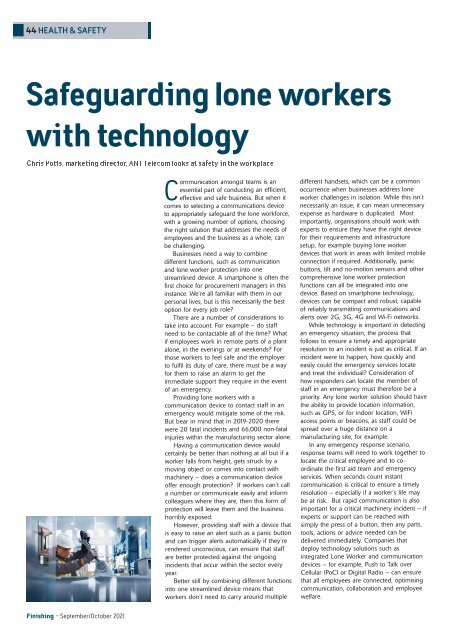You also want an ePaper? Increase the reach of your titles
YUMPU automatically turns print PDFs into web optimized ePapers that Google loves.
44 HEALTH & SAFETY<br />
Safeguarding lone workers<br />
with technology<br />
Communication amongst teams is an<br />
essential part of conducting an efficient,<br />
effective and safe business. But when it<br />
comes to selecting a communications device<br />
to appropriately safeguard the lone workforce,<br />
with a growing number of options, choosing<br />
the right solution that addresses the needs of<br />
employees and the business as a whole, can<br />
be challenging.<br />
Businesses need a way to combine<br />
different functions, such as communication<br />
and lone worker protection into one<br />
streamlined device. A smartphone is often the<br />
first choice for procurement managers in this<br />
instance. We’re all familiar with them in our<br />
personal lives, but is this necessarily the best<br />
option for every job role?<br />
There are a number of considerations to<br />
take into account. For example – do staff<br />
need to be contactable all of the time? What<br />
if employees work in remote parts of a plant<br />
alone, in the evenings or at weekends? For<br />
those workers to feel safe and the employer<br />
to fulfil its duty of care, there must be a way<br />
for them to raise an alarm to get the<br />
immediate support they require in the event<br />
of an emergency.<br />
Providing lone workers with a<br />
communication device to contact staff in an<br />
emergency would mitigate some of the risk.<br />
But bear in mind that in 2019-2020 there<br />
were 20 fatal incidents and 66,000 non-fatal<br />
injuries within the manufacturing sector alone.<br />
Having a communication device would<br />
certainly be better than nothing at all but if a<br />
worker falls from height, gets struck by a<br />
moving object or comes into contact with<br />
machinery – does a communication device<br />
offer enough protection? If workers can’t call<br />
a number or communicate easily and inform<br />
colleagues where they are, then this form of<br />
protection will leave them and the business<br />
horribly exposed.<br />
However, providing staff with a device that<br />
is easy to raise an alert such as a panic button<br />
and can trigger alerts automatically if they’re<br />
rendered unconscious, can ensure that staff<br />
are better protected against the ongoing<br />
incidents that occur within the sector every<br />
year.<br />
Better still by combining different functions<br />
into one streamlined device means that<br />
workers don’t need to carry around multiple<br />
different handsets, which can be a common<br />
occurrence when businesses address lone<br />
worker challenges in isolation. While this isn’t<br />
necessarily an issue, it can mean unnecessary<br />
expense as hardware is duplicated. Most<br />
importantly, organisations should work with<br />
experts to ensure they have the right device<br />
for their requirements and infrastructure<br />
setup, for example buying lone worker<br />
devices that work in areas with limited mobile<br />
connection if required. Additionally, panic<br />
buttons, tilt and no-motion sensors and other<br />
comprehensive lone worker protection<br />
functions can all be integrated into one<br />
device. Based on smartphone technology,<br />
devices can be compact and robust, capable<br />
of reliably transmitting communications and<br />
alerts over 2G, 3G, 4G and Wi-Fi networks.<br />
While technology is important in detecting<br />
an emergency situation, the process that<br />
follows to ensure a timely and appropriate<br />
resolution to an incident is just as critical. If an<br />
incident were to happen, how quickly and<br />
easily could the emergency services locate<br />
and treat the individual? Consideration of<br />
how responders can locate the member of<br />
staff in an emergency must therefore be a<br />
priority. Any lone worker solution should have<br />
the ability to provide location information,<br />
such as GPS, or for indoor location, WiFi<br />
access points or beacons, as staff could be<br />
spread over a huge distance on a<br />
manufacturing site, for example.<br />
In any emergency response scenario,<br />
response teams will need to work together to<br />
locate the critical employee and to coordinate<br />
the first aid team and emergency<br />
services. When seconds count instant<br />
communication is critical to ensure a timely<br />
resolution – especially if a worker’s life may<br />
be at risk. But rapid communication is also<br />
important for a critical machinery incident – if<br />
experts or support can be reached with<br />
simply the press of a button, then any parts,<br />
tools, actions or advice needed can be<br />
delivered immediately. Companies that<br />
deploy technology solutions such as<br />
integrated Lone Worker and communication<br />
devices – for example, Push to Talk over<br />
Cellular (PoC) or Digital Radio – can ensure<br />
that all employees are connected, optimising<br />
communication, collaboration and employee<br />
welfare.<br />
<strong>Finishing</strong> - <strong>September</strong>/<strong>October</strong> <strong>2021</strong>


















